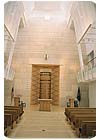The $10,000 Grand Prize in this year's Prism Awards was presented to a survivor of the 9/11 attacks, as judges honored the work done at the 90 West Street Building in New York, NY, which took a direct hit as the collapsing North Tower of the World Trade Center ripped through its granite facade. The distinguished honor of this year's top prize acknowledges the impressive restoration achieved by Conventional Stone & Marble Corp.
The competition places an emphasis on installations that demonstrated an original use of technology, or successfully combined aesthetics with function in a unique or interesting way.
Judges for this year's program were Rick Nelson, AIA, Booth Hansen Associates, Chicago, IL; Richard Becker, AIA, Becker Architects, Chicago; Steve Burns, AIA, Burns+Beyeri Architects, Inc., Chicago; and, Chuck Muehlbauer, MIA Technical Director.
This year's winners included:
- Grand Prize: 90 West Street Building, New York, NY
- Residential First Prize: Snowmass Village Residence, Aspen, CO
- Residential Award of Merit: “The Rain Catcher,†Ghent, NY
- Commercial Award of Merit: World Trade Center Plaza, Denver, CO
- ï€ Institutional First Prize: Albuquerque Museum of Art & History, Albuquerque, NM
- ï€ Institutional Award of Merit: Michigan Hall of Justice, Lansing, MI
- Special Award of Merit for Detail: Commodore Uriah P. Levy Center, Annapolis, MD

GRAND PRIZE: 90 West Street Building | New York, NY
Constructed in 1905 by Cass Gilbert and known as the Coal & Iron Building, 90 West Street in New York, NY, was designated an historic landmark in 1998 and actually was in the midst of a restoration and repurposing project for residential apartments when the fateful September 11, 2001 attacks occurred. The facade is famous for its ornamentation, with sculpted busts of lions, eagles, American Indian chiefs and other symbolic Americana that all were favorites of Gilbert. Around the 18th floor of this 23-story structure, he placed colonnade finials and finished the undersides of the arched windows with mosaics of yellow, green, blue and red terra-cotta tile.
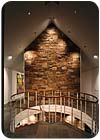
RESIDENTIAL FIRST PRIZE: Snowmass Village Residence | Aspen, CO
Legendary architect Hugh Newell Jacobsen wowed the judges, taking First Prize for his design of a picturesque stone house in Snowmass Village, Aspen, CO, that the judges said “connected with the landscape and became part of the site in the most natural way.†Sandstone exterior walls lend the house a sense of permanence. The palette is a deliberate choice to complement the wonderful color of the Aspen trees in the autumn months. This color coordination, both inside and outside the house, works together with a multi-pavilion plan to reduce the visual massiveness of the house and allow it to visually blend into the mountain.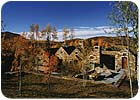
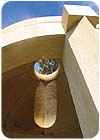
RESIDENTIAL AWARD OF MERIT: “The Rain Catcher†| Ghent, NY
The Award of Merit and $1,000 was conferred upon an extraordinary yellow limestone construction dubbed, “The Rain Catcher,†and submitted by Nayana Currimbhoy. The gazebo-like observatory - featuring four pillars topped by a dome - was fabricated in India by Sana Stone and installed in Ghent, NY. It is completely modular, with interlocking notched pieces that were assembled on site.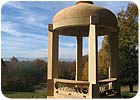

COMMERCIAL AWARD OF MERIT: World Trade Center Plaza | Denver, CO
For its work on behalf of Denver's World Trade Center Plaza, Design Workshop received the Prism Award of Merit and $1,000 cash prize in the commercial category. Granite was the material of choice for this landscaping assignment because its high compressive and flexural strength were appropriate for the harsh natural climate. The extensive color options were another plus for granite, allowing the formation of a pattern of vibrantly colored blocks inspired by Piet Mondrian's paintings.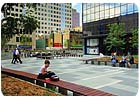
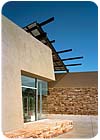
Institutional First Prize: Albuquerque Museum of Art & History | Albuquerque, NM
The recent expansion of the Albuquerque Museum of Art & History has yielded an interesting case study in stone and a First Prize Prism Award plus $2,000 for Rocky Mountain Stone's involvement in the project. A variety of materials - including travertine stone, copper, colorful stucco and glass - contributed to creating a fresh new identity for the museum, which is nearly three decades old.

Institutional Award of Merit: Michigan Hall of Justice | Lansing, MI
Inside and out, stone was instrumental in the design of the Michigan Hall of Justice in Lansing, MI, earning an Award of Merit for the Miami, FL-based architectural firm of Spillis Candela DMJM. The six-story, buff-colored Indiana limestone building - with its gently curved facade and arcades - defines a generous civic plaza. Additionally, black granite forms the base at ground level. More than 14,000 decorative cut panels were used, including 42-inch-diameter solid pieces for the entry columns.
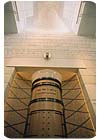
SPECIAL AWARD OF MERIT FOR DETAIL: Commodore Uriah P. Levy Center | Annapolis, MD
A Special Award of Merit for Detail and $1,000 were presented to Rugo Stone, LLC, Natural Stone & Mosaic Contractors of Lorton, VA, for its installation work on the Commodore Uriah P. Levy Center in Annapolis, MD. “This is a brilliant use of multiple finishes to create an exiting look in shear walls,†explained the judges. A massive amount of Jerusalem Stone was used in this project in a variety of unique ways. The concept was to create a scaled-down, 1,500-square-foot replica of the sacred Wailing Wall of Jerusalem, along with a chapel. A variety of hand-chiseled finishes that the architect saw in the original were skillfully recreated by the fabricator in Israel and also on site by Washington, DC-area stonemasons.